Land Suitability Analysis of Six Fruit Tree Species Immune/Resistant to Xylella fastidiosa as Alternative Crops in Infected Olive-Growing Areas
Abstract
:1. Introduction
2. Materials and Methods
2.1. Study Area
2.1.1. The Establishment of the Base Maps
2.1.2. Actual Land Use of the Study Areas
2.2. Alternative Fruit Tree Crops Selection
2.3. Parameters Used in the Land Suitability Analysis
2.3.1. Climate Suitability
2.3.2. Soil Suitability
2.4. Spatial Analysis and Land Suitability Map Generation
2.5. Data Analysis
3. Results and Discussion
3.1. Suitable Areas
3.2. Land Suitability Maps
4. Conclusions
Author Contributions
Funding
Data Availability Statement
Conflicts of Interest
References
- ISMEA. XVIII Rapporto Ismea-Qualivita, l’indagine socio-economica del comparto italiano agroalimentare e vitivinicolo DOP IGP. 2020. Available online: https://www.qualivita.it/rapporto-ismea-qualivita-2020/ (accessed on 30 September 2022).
- Saponari, M.; Boscia, D.; Nigro, F.; Martelli, G.P. Identification of DNA sequences related to Xylella fastidiosa in oleander, almond and olive trees exhibiting leaf scorch symptoms in Apulia (Southern Italy). J. Plant Pathol. 2013, 95, 3. [Google Scholar] [CrossRef]
- Camposeo, S.; Vivaldi, G.A.; Saponari, M. Attempts to Reduce the Systemic Spread of Xylella fastidiosa in Olive Trees by Pruning. Agronomy 2022, 12, 2917. [Google Scholar] [CrossRef]
- Scortichini, M.; Loreti, S.; Pucci, N.; Scala, V.; Tatulli, G.; Verweire, D.; Oehl, M.; Widmer, U.; Codina, J.M.; Hertl, P.; et al. Progress towards sustainable control of Xylella fastidiosa subsp. pauca in Olive Groves of Salento (Apulia, Italy). Pathogens 2021, 10, 668. [Google Scholar] [CrossRef] [PubMed]
- Sisterson, M.S.; Stenger, D.C. Roguing with replacement in perennial crops: Conditions for successful disease management. Phytopathology 2013, 103, 117–128. [Google Scholar] [CrossRef] [PubMed]
- Strobl, E. Preserving local biodiversity through crop diversification. Am. J. Agric. Econ. 2022, 104, 1140–1174. [Google Scholar] [CrossRef]
- Hooper, D.U.; Chapin, F.S., III; Ewel, J.J.; Hector, A.; Inchausti, P.; Lavorel, S.; Lawton, J.H.; Lodge, D.M.; Loreau, M.; Naeem, S.; et al. Effects of biodiversity on ecosystem functioning: A consensus of current knowledge. Ecol. Monogr. 2005, 75, 3–35. [Google Scholar] [CrossRef]
- De Boni, A.; D’Amico, A.; Acciani, C.; Roma, R. Crop diversification and resilience of drought-resistant species in semi-arid areas: An economic and environmental analysis. Sustainability 2022, 14, 9552. [Google Scholar] [CrossRef]
- Caruso, A.; Barbarossa, A.; Tassone, A.; Ceramella, J.; Carocci, A.; Catalano, A.; Basile, G.; Fazio, A.; Iacopetta, D.; Franchini, C.; et al. Pomegranate: Nutraceutical with promising benefits on human health. Appl. Sci. 2020, 10, 6915. [Google Scholar] [CrossRef]
- Barreca, D.; Nabavi, S.M.; Sureda, A.; Rasekhian, M.; Raciti, R.; Silva, A.S.; Annunziata, G.; Arnone, A.; Tenore, G.C.; Süntar, I.; et al. Almonds (Prunus dulcis Mill. DA webb): A source of nutrients and health-promoting compounds. Nutrients 2020, 12, 672. [Google Scholar] [CrossRef]
- Sharma, J.; Ramchandra, K.K.; Sharma, D.; Meshram, D.T.; Ashis Maity, N.N. POMEGRANATE: Cultivation, Marketing and Utilization. Technical Bulletin; ICAR-National Research Centre on Pomegranate: Solapur, India, 2014. [Google Scholar]
- De Leijster, V.; Santos, M.J.; Wassen, M.J.; Ramos-Font, M.E.; Robles, A.B.; Díaz, M.; Staal, M.; Verweij, P.A. Agroecological Management Improves Ecosystem Services in Almond Orchards within One Year. Ecosyst. Serv. 2019, 38, 100948. [Google Scholar] [CrossRef]
- Sottile, F.; Massaglia, S.; Peano, C. Ecological and Economic Indicators for the Evaluation of Almond (Prunus dulcis L.) Orchard Renewal in Sicily. Agriculture 2020, 10, 301. [Google Scholar] [CrossRef]
- Ali, B.M.; van der Werf, W.; Lansink, A.O. Assessment of the environmental impacts of Xylella fastidiosa subsp. Pauca in Puglia. J. Crop. Prot. 2021, 142, 105519. [Google Scholar] [CrossRef]
- Saponari, M.; Giampetruzzi, A.; Loconsole, G.; Boscia, D.; Saldarelli, P. Xylella fastidiosa in olive in Apulia: Where we stand. Phytopathology 2019, 109, 175–186. [Google Scholar] [CrossRef] [PubMed]
- Bowles, T.M.; Mooshammer, M.; Socolar, Y.; Calderón, F.; Cavigelli, M.A.; Culman, S.W.; Deen, W.; Drury, C.F.; Garciay Garcia, A.; Gaudin, A.C.; et al. Long-Term Evidence Shows That Crop-Rotation Diversification Increases Agricultural Resilience to Adverse Growing Conditions in North America. One Earth 2020, 2, 284–293. [Google Scholar] [CrossRef]
- Xu, E.; Zhang, H. Spatially-explicit sensitivity analysis for land suitability evaluation. Appl. Geogr. 2013, 45, 1–9. [Google Scholar] [CrossRef]
- Talukdar, S.; Naikoo, M.W.; Mallick, J.; Praveen, B.; Sharma, P.; Islam, A.R.M.T.; Pal, S.; Rahman, A. Coupling geographic information system integrated fuzzy logic-analytical hierarchy process with global and machine learning based sensitivity analysis for agricultural suitability mapping. Agric. Syst. 2022, 196, 103343. [Google Scholar] [CrossRef]
- Ferretti, V.; Pomarico, S. Ecological land suitability analysis through spatial indicators: An application of the Analytic Network Process technique and Ordered Weighted Average approach. Ecol. Indic. 2013, 34, 507–519. [Google Scholar] [CrossRef]
- Liu, Y.S.; Wang, J.Y.; Guo, L.Y. GIS-based assessment of land suitability for optimal allocation in the Qinling Mountains, China. Pedosphere 2006, 16, 579–586. [Google Scholar] [CrossRef]
- Food and Agriculture Organization of the United Nations (FAO). A Framework for Land Evaluation; Soils Bulletin No. 32; FAO: Rome, Italy, 1976; p. 72. [Google Scholar]
- Herzberg, R.; Pham, T.G.; Kappas, M.; Wyss, D.; Tran, C.T.M. Multi-criteria decision analysis for the land evaluation of potential agricultural land use types in a hilly area of Central Vietnam. Land 2019, 8, 90. [Google Scholar] [CrossRef]
- He, Y.; Yao, Y.; Chen, Y.; Ongaro, L. Regional Land Suitability Assessment for Tree Crops Using Remote Sensing and GIS. In Proceedings of the International Conference on Computer Distributed Control and Intelligent Environmental Monitoring, Changsha, China, 19–20 February 2011; pp. 354–363. [Google Scholar] [CrossRef]
- Labianca, M.; De Rubertis, S.; Belliggiano, A.; Salento, A. Innovation in rural development in Puglia, Italy: Critical issues and potentialities starting from empirical evidence. Stud. Agric. Econ. 2016, 118, 38–46. [Google Scholar] [CrossRef]
- Ciervo, M. The olive quick decline syndrome (OQDS) diffusion in Apulia Region: An apparent contradiction according to the agricultural model. Belgeo Rev. Belg. De Géographie 2016. Available online: https://www.researchgate.net/publication/320002375_The_olive_quick_decline_syndrome_OQDS_diffusion_in_Apulia_Region_An_apparent_contradiction_according_to_the_agricultural_model (accessed on 1 December 2022). [CrossRef]
- Bollettino Ufficiale della Regione Puglia—n. 128 del 24-11-2022. DETERMINAZIONE DEL DIRIGENTE SEZIONE OSSERVATORIO FITOSANITARIO 17 novembre 2022, n. 127 Xylella fastidiosa sottospecie Pauca ST53—Aggiornamento delle aree delimitate ai sensi dell’art. 4 del Reg. UE 2020/1201. Available online: https://burp.regione.puglia.it/documents/20135/1989895/DET_127_17_11_2022.pdf/6fc14137-0764-9c15-f307-b3e52c67c824?version=1.1&t=1669302442483 (accessed on 10 December 2022).
- European Food Safety Authority (EFSA); Delbianco, A.; Gibin, D.; Pasinato, L.; Morelli, M. Update of the Xylella spp. host plant database–systematic literature search up to 31 December 2020. EFSA 2021, 19, 06674. [Google Scholar] [CrossRef]
- Baldi, P.; La Porta, N. Xylella fastidiosa: Host range and advance in molecular identification techniques. Front. Plant Sci. 2017, 8, 944. [Google Scholar] [CrossRef] [PubMed]
- Giménez-Bastida, J.A.; Ávila-Gálvez, M.Á.; Espín, J.C.; González-Sarrías, A. Evidence for Health Properties of Pomegranate Juices and Extracts beyond Nutrition: A Critical Systematic Review of Human Studies. Trends Food Sci. Technol. 2021, 114, 410–423. [Google Scholar] [CrossRef]
- ISMEA. Filiera Frutto a Guscio, Scheda di Settore–Giugno 2021. Available online: https://www.reterurale.it/flex/cm/pages/ServeAttachment.php/L/IT/D/1%252F0%252F0%252FD.d1c1cf1855fc3f294056/P/BLOB%3AID%3D23077/E/pdf (accessed on 10 December 2022).
- Alasalvar, C.; Salas-Salvadó, J.; Ros, E.; Sabaté, J. An overview. In Health Benefits of Nuts and Dried Fruits, 1st ed.; Taylor Francis: Abingdon, UK, 2020; pp. 1–9. [Google Scholar]
- Khalil, H.A. Morphological and physiological performance and drought resistance improvement of pomegranate seedlings by mycorrhizal inoculation. J. Plant Prod. 2015, 6, 2145–2162. [Google Scholar] [CrossRef]
- Donati, I.; Cellini, A.; Sangiorgio, D.; Caldera, E.; Sorrenti, G.; Spinelli, F. Pathogens associated to kiwifruit vine decline in Italy. Agriculture 2020, 10, 119. [Google Scholar] [CrossRef]
- Sportelli, G.F. Il kiwi torna in Puglia (The Kiwifruit is Coming Back in Apulia). Terra e Vita. 2021. Available online: https://terraevita.edagricole.it/frutticoltura-orticoltura/kiwi-torna-in-puglia-ma-diverso-da-anni-80-secolo-scorso/ (accessed on 7 December 2022).
- Savoia, M.A.; Del Faro, L.; Venerito, P.; Gaeta, L.; Palasciano, M.; Montemurro, C.; Sabetta, W. The Relevance of Discovering and Recovering the Biodiversity of Apulian Almond Germplasm by Means of Molecular and Phenotypic Markers. Plants 2022, 11, 574. [Google Scholar] [CrossRef]
- Torrecillas, A.; Alarcón, J.J.; Domingo, R.; Planes, J.; Sánchez-Blanco, M.J. Strategies for drought resistance in leaves of two almond cultivars. Plant Sci. 1996, 118, 135–143. [Google Scholar] [CrossRef]
- Del Carmen Gijón, M.; Gimenez, C.; Perez-López, D.; Guerrero, J.; Couceiro, J.F.; Moriana, A. Water relations of pistachio (Pistacia vera L.) as affected by phenological stages and water regimes. Sci. Hortic. 2011, 128, 415–422. [Google Scholar] [CrossRef]
- Elloumi, O.; Ghrab, M.; Kessentini, H.; Mimoun, M.B. Chilling accumulation effects on performance of pistachio trees cv. Mateur in dry and warm area climate. Sci. Hortic. 2013, 159, 80–87. [Google Scholar] [CrossRef]
- Ibnouali-El-Aloui, M.; Bari, A.; Oukabli, A.; Mekaoui, A. Contribution to identification of fig (Ficus carica) genotypes tolerant to drought. III Int. Symp. Fig. May 2005, 798, 87–93. [Google Scholar] [CrossRef]
- Zhang, Y.; Chen, Q.; Lan, J.; Luo, Y.; Wang, X.; Chen, Q.; Sun, B.; Wang, Y.; Gong, R.; Tang, H. Effects of drought stress and rehydration on physiological parameters and proline metabolism in kiwifruit seedling. Int. J. Agric. Biol. 2018, 20, 2891–2896. [Google Scholar] [CrossRef]
- Awada, T.; Josiah, S. Physiological responses of four hazelnut hybrids to water availability in Nebraska. Gt. Plains Res. 2007, 17, 193–202. [Google Scholar]
- Akıncı, H.; Özalp, A.Y.; Turgut, B. Agricultural land use suitability analysis using GIS and AHP technique. Comput. Electron. Agric. 2013, 97, 71–82. [Google Scholar] [CrossRef]
- Khan, M.S.N.; Khan, M.M.A. Land suitability analysis for sustainable agricultural land use planning in Bulandshahr District of Uttar Pradesh. Int. J. Sci. Res. Publ. 2014, 4, 1–11. [Google Scholar]
- Khan, M.A.; Ahmad, R.; Khan, H.H. Multi-Criteria Land Suitability Analysis for Agriculture Using AHP and Remote Sensing Data of Northern Region India. In Geographic Information Systems and Applications in Coastal Studies [Working Title]; Zhang, Y., Cheng, Q., Eds.; IntechOpen: London, UK, 2022. [Google Scholar] [CrossRef]
- Hudait, M.; Patel, P.P. Site suitability assessment for traditional betel vine cultivation and crop acreage expansion in Tamluk Subdivision of Eastern India using AHP-based multi-criteria decision making approach. Comput. Electron. Agric. 2022, 200, 107220. [Google Scholar] [CrossRef]
- Steduto, P.; Todorovic, M. The Agro-ecological characterisation of Apulia region (Italy): Methodology and experience. In Soil Resources of Southern and Eastern Mediterranean Countries; Options Méditerranéennes: Série B. Etudes et Recherches; Zdruli, P., Steduto, P., Lacirignola, C., Montanarella, L., Eds.; CIHEAM: Bari, Italy, 2001; Volume 34, pp. 143–158. Available online: http://om.ciheam.org/article.php?IDPDF=1002091 (accessed on 10 December 2022).
- Alonso, J.M.; Ansón, J.M.; Espiau, M.T. Determination of endodormancy break in almond flower buds by a correlation model using the average temperature of different day intervals and its application to the estimation of chill and heat requirements and blooming date. J. Am. Soc. Hortic. Sci. 2005, 130, 308–318. [Google Scholar] [CrossRef]
- Benmoussa, H.; Ghrab, M.; Mimoun, M.B.; Luedeling, E. Chilling and heat requirements for local and foreign almond (Prunus dulcis Mill.) cultivars in a warm Mediterranean location based on 30 years of phenology records. Agric. For. Meteorol. 2017, 239, 34–46. [Google Scholar] [CrossRef]
- Isa, M.M.; Jaafar, M.N.; Kasim, K.F.; Mutalib, M.F.A. Cultivation of fig (Ficu scarica L.) as an alternative high value crop in Malaysia: A brief review. In IOP Conference Series: Materials Science and Engineering; IOP Publishing: Bristol, UK, 2020; Volume 864, No. 1; p. 012134. [Google Scholar]
- Ferguson, L.; Haviland, D. Pistachio Production Manual; UCANR: Davis, CA, USA, 2016; Volume 3545. [Google Scholar]
- Mehlenbacher, S.A. Chilling requirements of hazelnut cultivars. Sci. Hortic. 1991, 47, 271–282. [Google Scholar] [CrossRef]
- Peticila, A.; Scaeteanu, G.V.; Madjar, R.; Stanica, F.; Asanica, A. Fertilization effect on mineral nutrition of Actinidia deliciosa (kiwi) cultivated on different substrates. Agric. Sci. Proc. 2015, 6, 132–138. [Google Scholar] [CrossRef] [Green Version]
- Kuden, A.B.; Kaska, N. Determination of the chilling requirements and growing degree hours of some local almond cultivars. Doga Bilim Dergisi. 1993, 17, 197–203. [Google Scholar]
- Yarahmadi, J.; Amini, A. Determining land suitability for pistachio cultivation development based on climate variables to adapt to drought. Theor. Appl. Climatol. 2021, 143, 1631–1642. [Google Scholar] [CrossRef]
- Chandra, R.; Suroshe, S.; Sharma, J.; Marathe, R.A.; Meshram, D.T. Pomegranate Growing Manual; ICAR-National Research Center on Pomegranate: Solapur, India, 2011. [Google Scholar]
- Blumenfeld, A.; Shaya, F.; Hillel, R. Cultivation of pomegranate. Options Méditerranéennes Ser. A 2000, 42, 143–147. [Google Scholar]
- Soloklui, A.A.G.; Gharaghani, A.; Oraguzie, N.; Eshghi, S.; Vazifeshenas, M. Chilling and heat requirements of 20 Iranian pomegranate cultivars and their correlations with geographical and climatic parameters, as well as tree and fruit characteristics. HortScience 2017, 52, 560–565. [Google Scholar] [CrossRef]
- Moral, F.J.; García-Martín, A.; Rebollo, F.J.; Rozas, M.A.; Paniagua, L.L. GIS-Based Analysis and Mapping of the Winter Chilling Hours in Mainland Spain. Application to Some Sweet Cherry Cultivars. Agronomy 2021, 11, 330. [Google Scholar] [CrossRef]
- Weinberger, J.H. Chilling requirements of peach varieties. Proc. Am. Soc. Hort. Sci. 1950, 56, 122–128. [Google Scholar]
- Everest, T. Suitable site selection for pistachio (Pistacia vera) by using GIS and multi-criteria decision analyses (a case study in Turkey). Environ. Dev. Sustain. 2021, 23, 7686–7705. [Google Scholar] [CrossRef]
- Leisz, S.J.; Lam, N.T.; Vien, T.D. Developing a methodology for identifying, mapping and potentially monitoring the distribution of general farming system types in Vietnam’s northern mountain region. Agric. Syst. 2005, 85, 340–363. [Google Scholar] [CrossRef]
- Selim, S.; Koc-San, D.; Selim, C.; San, B.T. Site selection for avocado cultivation using GIS and multi-criteria decision analyses: Case study of Antalya, Turkey. Comput. Electron. Agric. 2018, 154, 450–459. [Google Scholar] [CrossRef]
- Borgogno-Mondino, E.; Farbo, A.; Novello, V.; Palma, L.D. A Fast Regression-Based Approach to Map Water Status of Pomegranate Orchards with Sentinel 2 Data. Horticulturae 2022, 8, 759. [Google Scholar] [CrossRef]
- Resta, P.; Roselli, M.; Palasciano, M.A.; Lamaj, F.; Fanizza, G.; Ferrara, E. Detection of Multiple Denominations of the Same Fig Genotypes Grown in Southern Italy. Acta Hortic. 2008, 798, 169–176. [Google Scholar] [CrossRef]
- Chelli-Chaabouni, A.; Trad, M.; Mkadmi, M.; Ouerghui, I.; Mlayah, O.; Jemaii, H. Pistachio performance in the southern Mediterranean: Towards optimal use of genetic resources to increase productivity of rainfed agriculture. Euro-Mediterr. J. Environ. Integr. 2021, 6, 1–10. [Google Scholar] [CrossRef]
- Kaska, N. Pistachio nut growing in the Mediterranean basin. Acta Hortic. 2002, 591, 443–455. [Google Scholar] [CrossRef]
- Roxas, A.A.; Marino, G.; Avellone, G.; Caruzo, T.; Marra, F.P. The effect of plant water status on the chemical composition of pistachio nuts (Pistacia vera L. Cultivar Bianca). Agriculture 2020, 10, 167. [Google Scholar] [CrossRef]
- Malczewski, J. Ordered weighted averaging with fuzzy quantifiers: GIS-based multicriteria evaluation for land-use suitability analysis. Int. J. Appl. Earth Obs. Geoinf. 2006, 8, 270–277. [Google Scholar] [CrossRef]
- Ferrara, G.; Cavoski, I.; Pacifico, A.; Tedone, L.; Mondelli, D. Morpho-pomological and chemical characterization of pomegranate (Punica granatum L.) genotypes in Apulia region, Southeastern Italy. Sci. Hortic. 2011, 130, 599–606. [Google Scholar] [CrossRef]
- De Giorgio, D.; Leo, L.; Zacheo, G.; Lamascese, N. Evaluation of 52 almond (Prunus amygdalus Batsch) cultivars from the Apulia region in Southern Italy. J. Hortic. Sci. Biotechnol. 2007, 82, 541–546. [Google Scholar] [CrossRef]
- Cradock-Henry, N.A. New Zealand kiwifruit growers’ vulnerability to climate and other stressors. Reg. Environ. Chang. 2017, 17, 245–259. [Google Scholar] [CrossRef]
- Snelgar, W.P.; Hall, A.J.; McPherson, H.G. Modelling flower production of kiwifruit (Actinidia deliciosa) from winter chilling. N. Z. J. Crop. Hortic. Sci. 2008, 36, 273–284. [Google Scholar] [CrossRef]
- Ferguson, A.R. Kiwifruit (Actinidia). Genet. Resour. Temp. Fruit Nut Crops. 1991, 290, 603–656. [Google Scholar] [CrossRef]
- Matarazzo, A.; Clasadonte, M.T.; Giudice, A.L. Implementation of guidelines for eco-labelling in the agri-food smes: The Sicilian pistachio sector. Procedia Environ. Sci. Eng. Manag. 2015, 2, 73–84. [Google Scholar]
- Zeinadini, A.; Navidi, M.N.; Eskandari, M.; Seyedmohammadi, J.; Toomanian, N.; Hosseinifard, S.J.; Farajnia, A.; Ghasemzadeh Ganjehie, M. Determination of Soil and Landscape Requirements of Pistachio for Use in Land Suitability Evaluation. J. Pist. Sci. Technol. 2020, 5, 70–88. [Google Scholar]
- Dimitrijević, B.; Bulatović, B. Situation and possibilities for the production of hazelnut in Serbia. Agric. Manag./Lucrari Stiintifice Seria I Manag. Agricol. 2010, 12, 1–8. [Google Scholar]
- Jha, P.K.; Materia, S.; Zizzi, G.; Costa-Saura, J.M.; Trabucco, A.; Evans, J.; Bregaglio, S. Climate change impacts on phenology and yield of hazelnut in Australia. Agric. Syst. 2021, 186, 102982. [Google Scholar] [CrossRef]
- Food and Agriculture Organization (FAO). Hazelnuts (with Shell), Crops by Countries, Years, Area Harvested, Yield and Production Quantity; UN, Statistics Division: New York, NY, USA, 2019. [Google Scholar]
- FAOSTAT. Available online: http://faostat3.fao.org/faostat/en/#data/QCL (accessed on 6 December 2022).
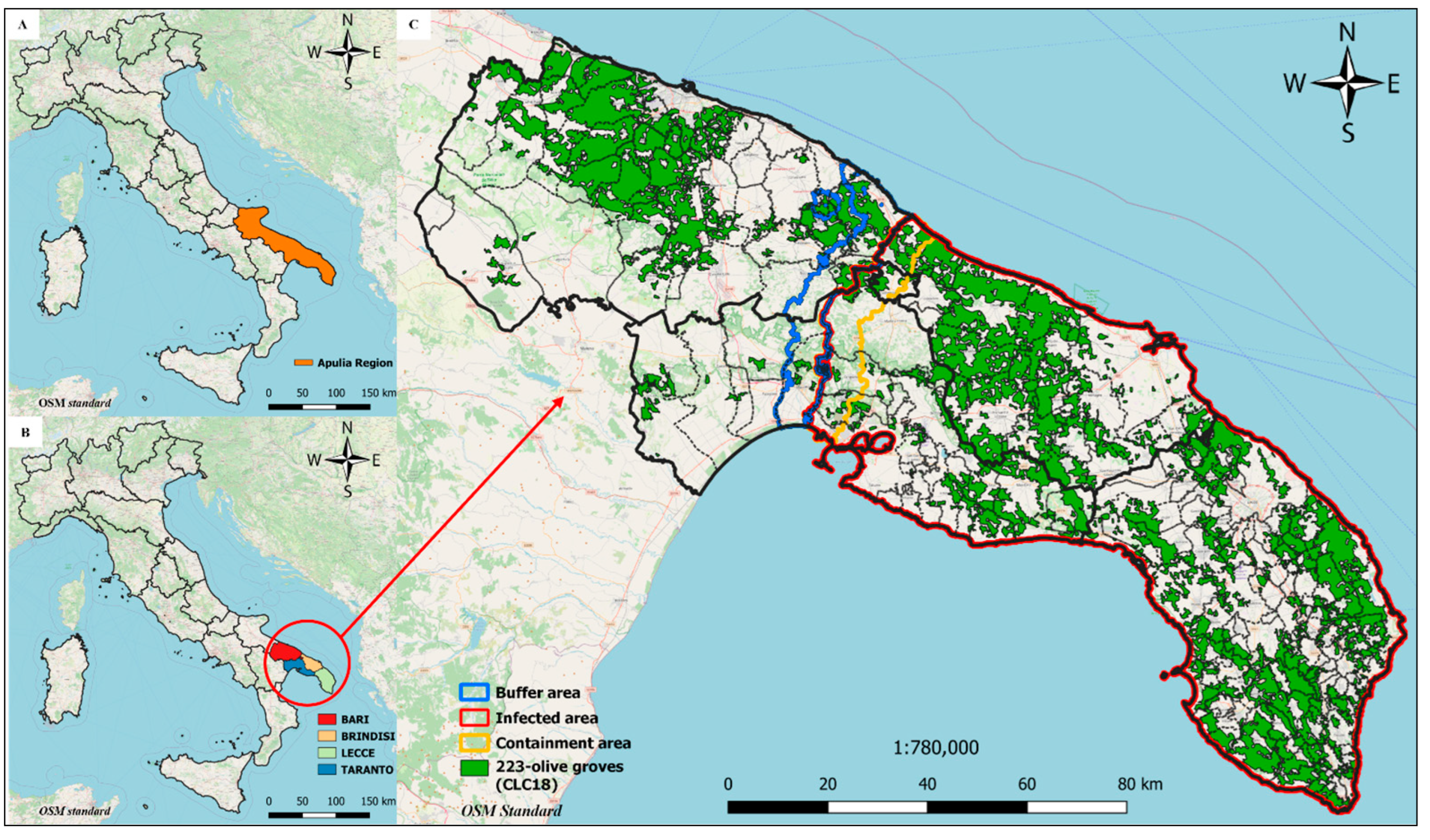
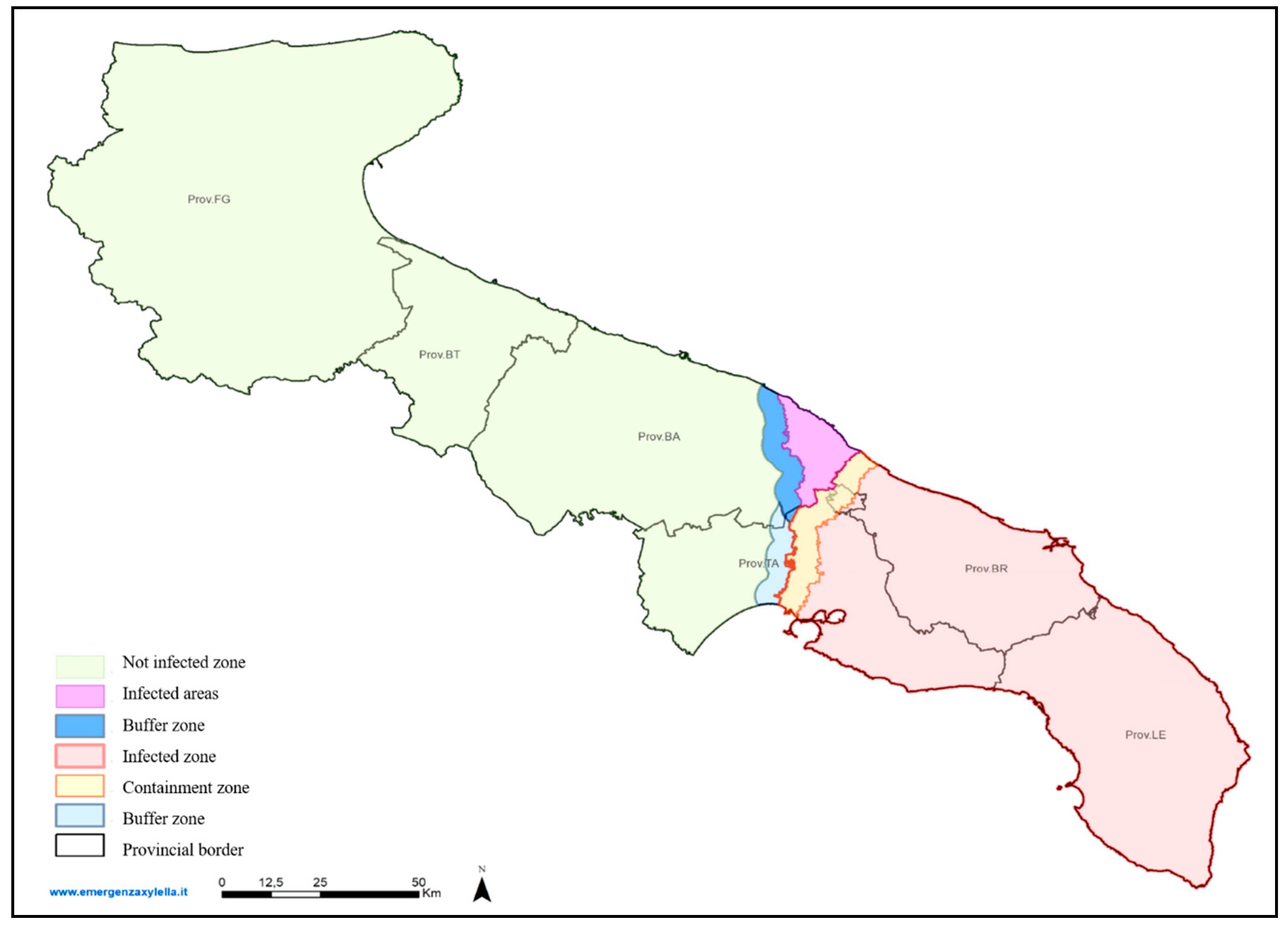
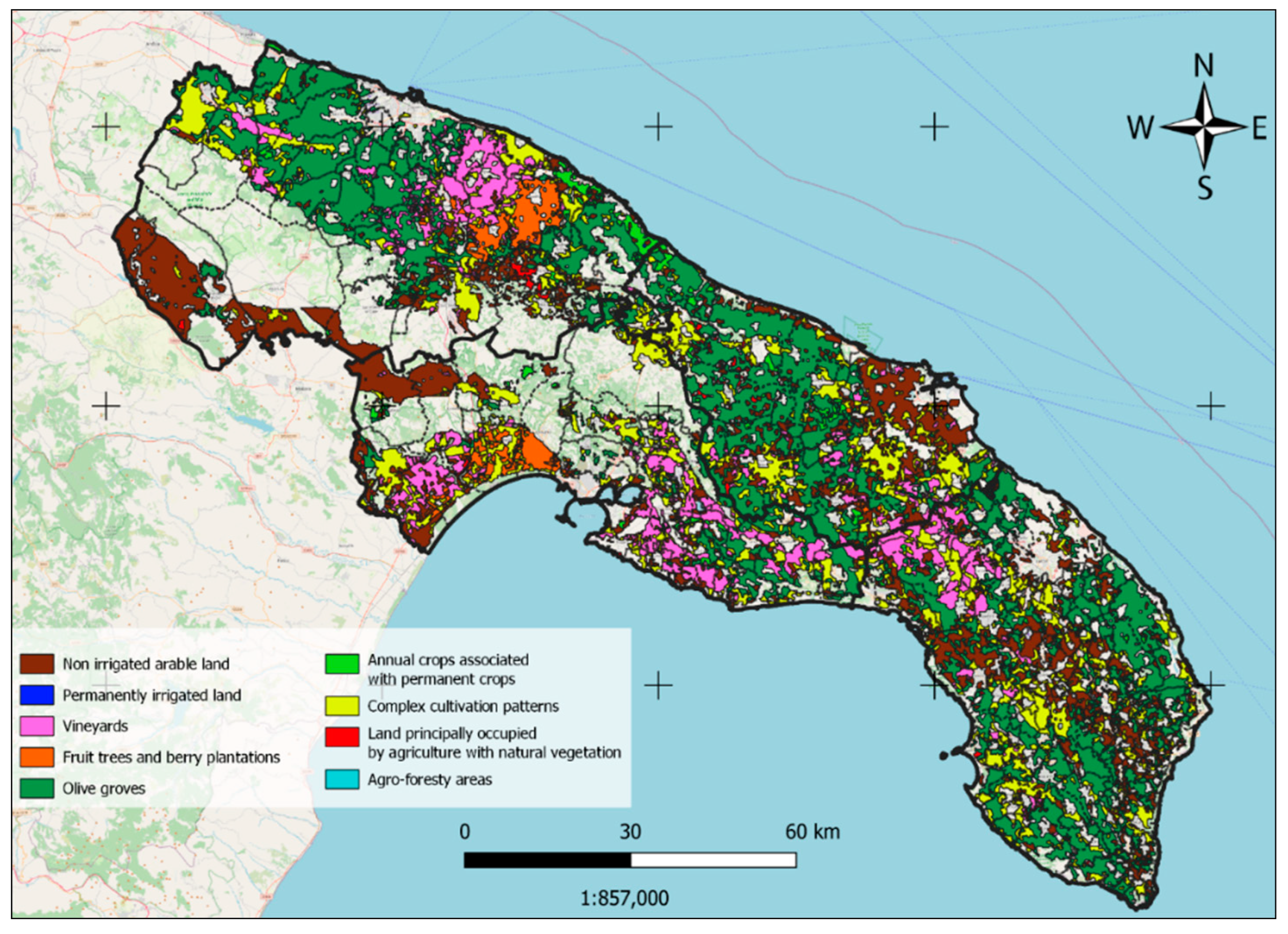
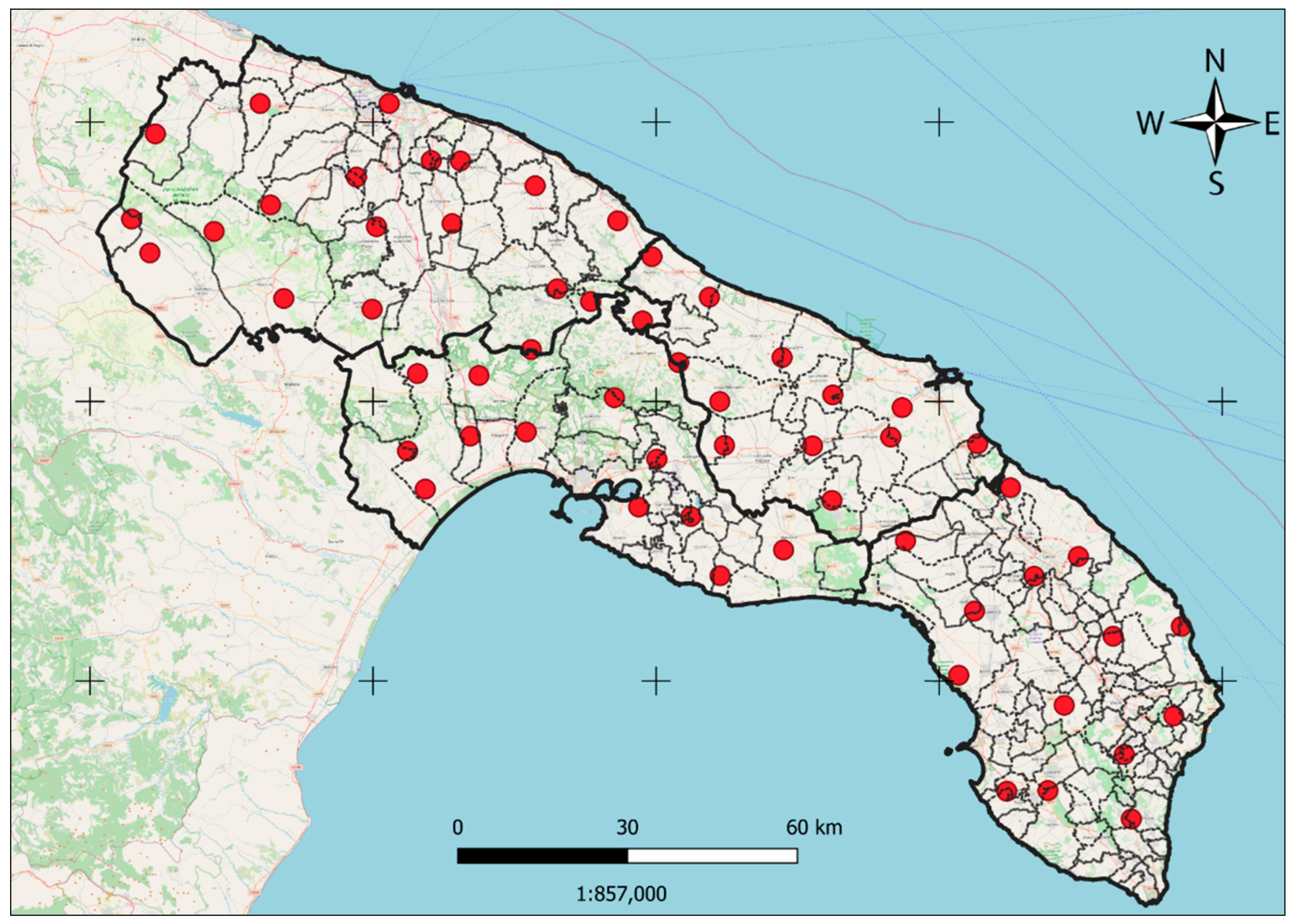
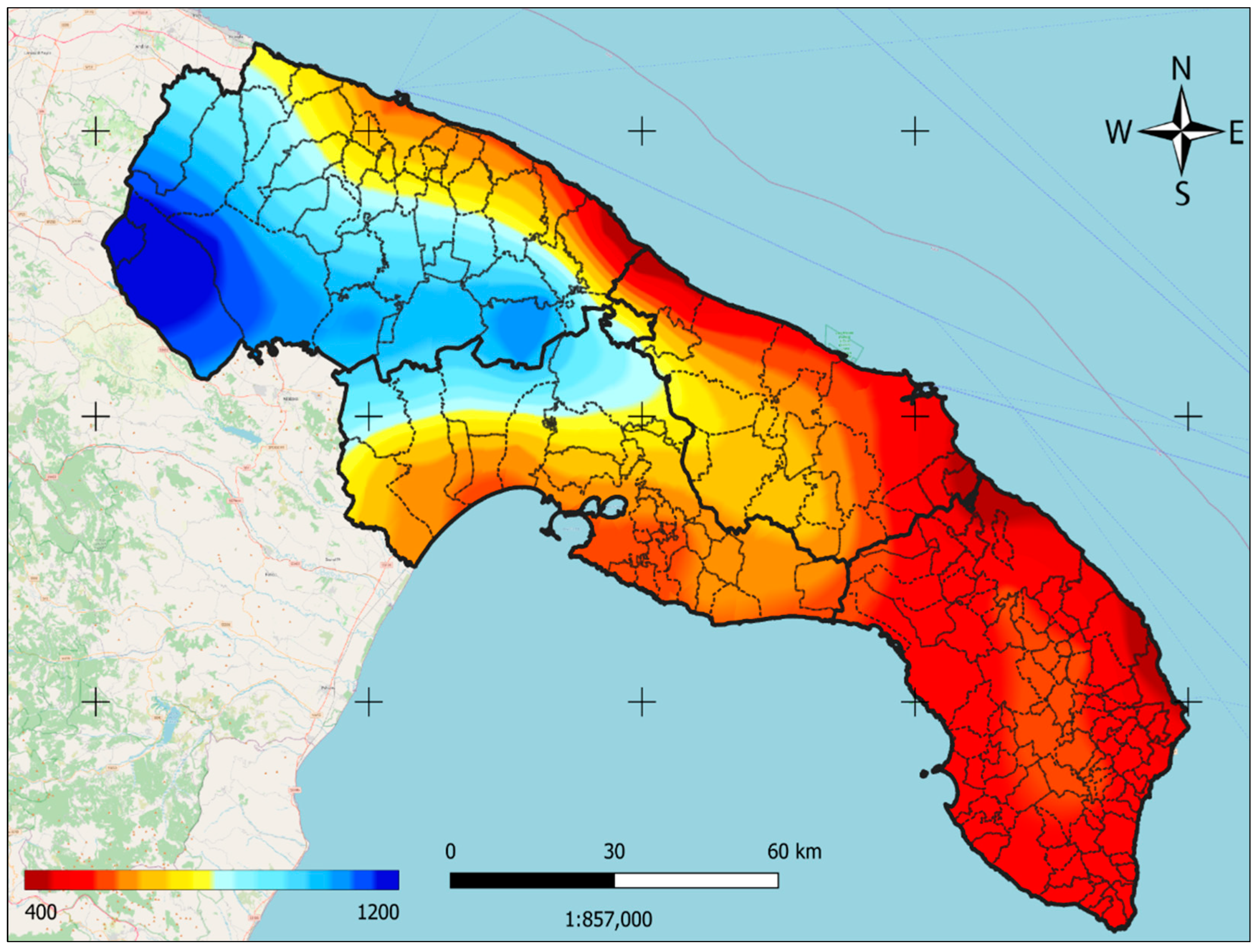
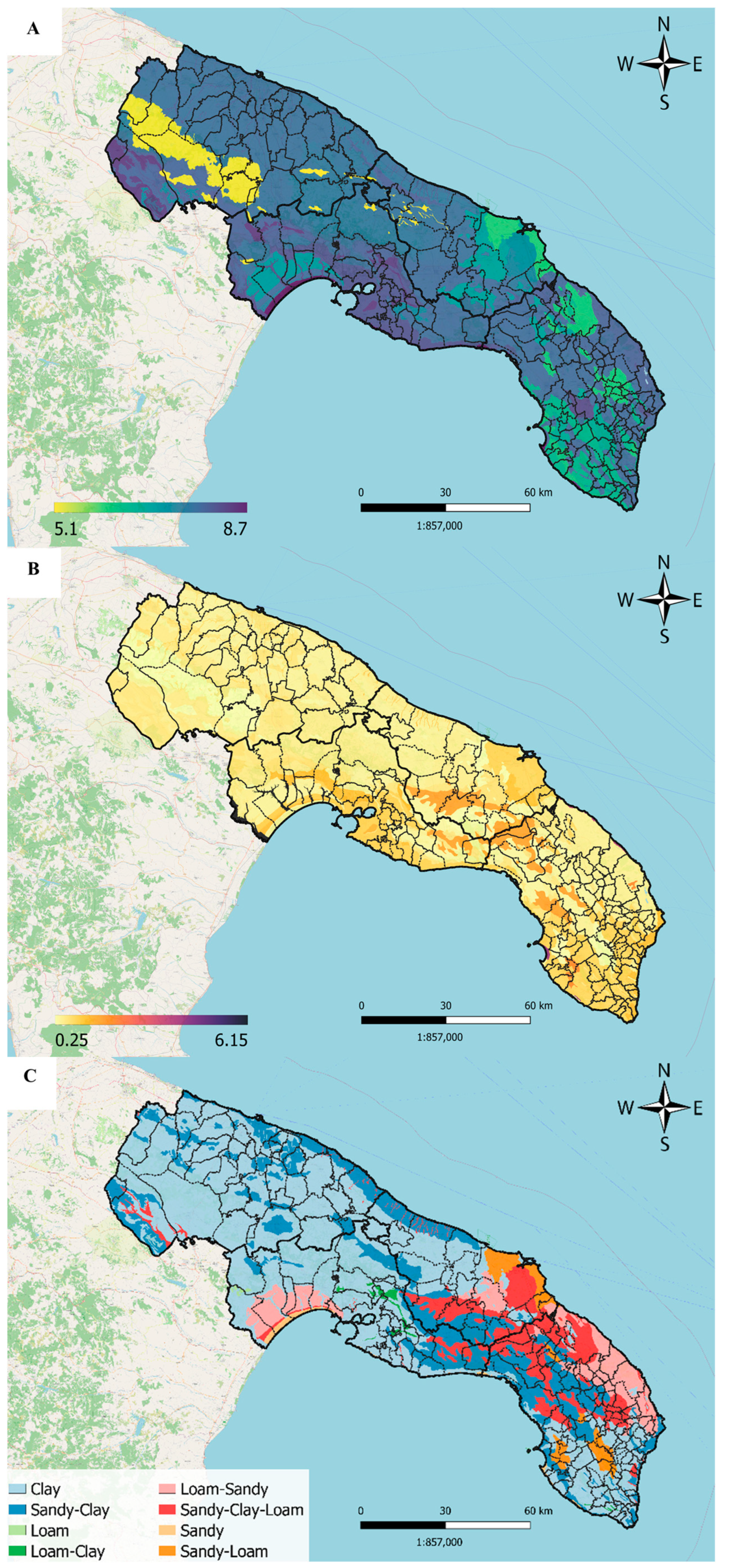
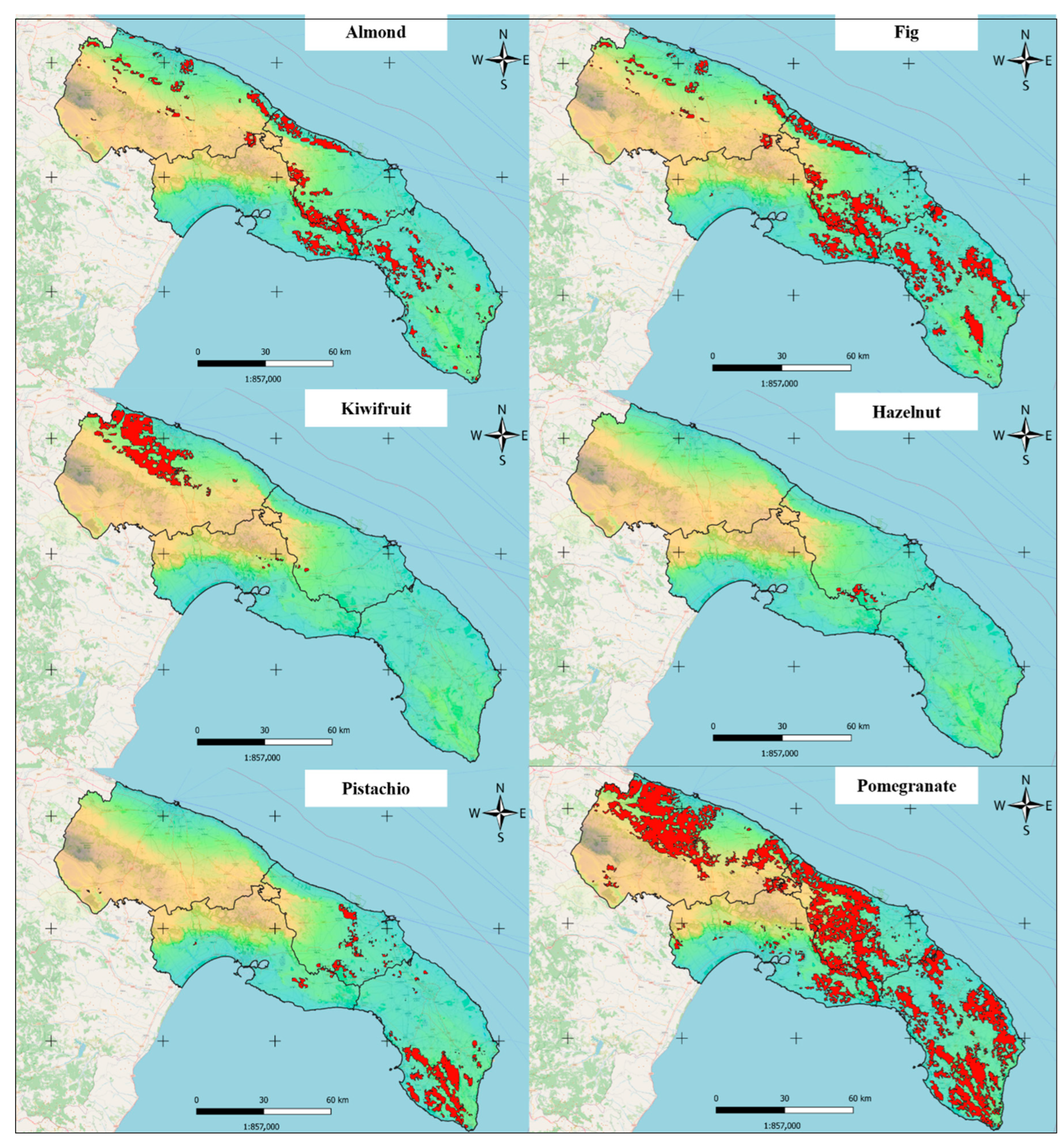
| Fruit Tree Crop | Chilling Requirement (h) | Soil Texture * | Soil pH | Soil Salinity (ECe; dS/m) | References |
|---|---|---|---|---|---|
| Almond | 350–500 | S, SC, CL | 5.5–8.5 | <2.0 | [47,48] |
| Fig | 300–500 | wide range of soils (S, SCL, LS, L, C) | 6.0–6.8 | <4.2 | [49] |
| Hazelnut | >600 | L, SCL, CL, SC | 6.0–7.0 | <2.0 | [50,51] |
| Kiwifruit | 700–1000 | C, CL | 5.5–7.0 | <0.4 | [52] |
| Pistachio | 600–1000 | SC | 6.5–7.5 | <6.0–8.0 | [53,54] |
| Pomegranate | 230–630 | All type of soils | 6.5–7.5 | <6.0 | [55,56,57] |
| Fruit Tree Crop | Total Area (ha) | Area by Province (ha) | |||
|---|---|---|---|---|---|
| Bari | Taranto | Brindisi | Lecce | ||
| Almond | 70,537 | 12,596 | 14,143 | 25,737 | 18,061 |
| Fig | 103,975 | 12,503 | 15,239 | 35,503 | 40,730 |
| Hazelnut | 2744 | 0 | 460 | 2227 | 57 |
| Kiwifruit | 43,018 | 42,303 | 382 | 333 | 0 |
| Pomegranate | 268,886 | 88,958 | 22,037 | 71,135 | 86,756 |
| Pistachio | 40,583 | 82 | 1768 | 7902 | 30,831 |
Disclaimer/Publisher’s Note: The statements, opinions and data contained in all publications are solely those of the individual author(s) and contributor(s) and not of MDPI and/or the editor(s). MDPI and/or the editor(s) disclaim responsibility for any injury to people or property resulting from any ideas, methods, instructions or products referred to in the content. |
© 2023 by the authors. Licensee MDPI, Basel, Switzerland. This article is an open access article distributed under the terms and conditions of the Creative Commons Attribution (CC BY) license (https://creativecommons.org/licenses/by/4.0/).
Share and Cite
Alhajj Ali, S.; Vivaldi, G.A.; Garofalo, S.P.; Costanza, L.; Camposeo, S. Land Suitability Analysis of Six Fruit Tree Species Immune/Resistant to Xylella fastidiosa as Alternative Crops in Infected Olive-Growing Areas. Agronomy 2023, 13, 547. https://doi.org/10.3390/agronomy13020547
Alhajj Ali S, Vivaldi GA, Garofalo SP, Costanza L, Camposeo S. Land Suitability Analysis of Six Fruit Tree Species Immune/Resistant to Xylella fastidiosa as Alternative Crops in Infected Olive-Growing Areas. Agronomy. 2023; 13(2):547. https://doi.org/10.3390/agronomy13020547
Chicago/Turabian StyleAlhajj Ali, Salem, Gaetano Alessandro Vivaldi, Simone Pietro Garofalo, Leonardo Costanza, and Salvatore Camposeo. 2023. "Land Suitability Analysis of Six Fruit Tree Species Immune/Resistant to Xylella fastidiosa as Alternative Crops in Infected Olive-Growing Areas" Agronomy 13, no. 2: 547. https://doi.org/10.3390/agronomy13020547
APA StyleAlhajj Ali, S., Vivaldi, G. A., Garofalo, S. P., Costanza, L., & Camposeo, S. (2023). Land Suitability Analysis of Six Fruit Tree Species Immune/Resistant to Xylella fastidiosa as Alternative Crops in Infected Olive-Growing Areas. Agronomy, 13(2), 547. https://doi.org/10.3390/agronomy13020547







